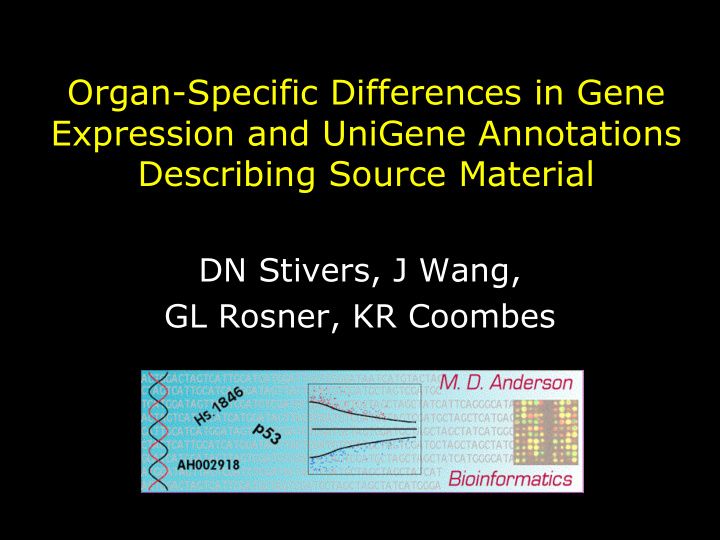



Organ-Specific Differences in Gene Expression and UniGene Annotations Describing Source Material DN Stivers, J Wang, GL Rosner, KR Coombes
Background Reference Project normal: defining normal variance in mouse gene expression. Pritchard, Hsu, Delrow and Nelson. PNAS 98 (2001) 13266-13271.
Experimental Design • Eighteen samples � Six C57BL6 male mice � Three organs: kidney, liver, testis • Reference material � Pool all eighteen mouse organs • Replicate microarray experiments using two-color fluorescence with common reference � Four experiments per mouse organ � Two red samples, two green samples
Their Analysis • Print-tip specific intensity dependent loess normalization • Scale adjusted (MAD) • Use log ratios for further analysis � Log(experimental/reference) • Perform F-test for each gene to see if mouse-to-mouse variance exceeds the array-to-array variance
Why Loess Normalization? • Normalization methods assume: � Distributions of intensities are the same in the two channels � Most genes do not change expression � The number of overexpressed genes is about the same as the number of underexpressed genes • Loess normalization tries to force the distributions in the two channels to match, believing that differences are attributable to technology.
Theoretical Distribution Lots ? Twice as many ?
Our Data Processing: Keep It Simple • Normalize channels separately • Divide by 75 th percentile � A magic number, but it avoids division by nominal zero • Multiply by 10 � A completely arbitrary number that has no effect on any of the analysis • Set threshold at 0.5 � More magic, chosen as five percent of the previous scaling factor • Log transform
Comparison Between Channels Simulated From This Mixture
Real Data
Real Data
Interpretation • Distributions of intensities are different in the two channels. • Difference is NOT caused by arrays, dyes, or technology. • Difference is inherent in the choice of reference material.
A Question • Can we determine from this data set which genes are specifically expressed in each of the three organs? • This question will become more important very soon…
Principal Components
When Bad Things Happen to Good Data • Data was supplied in three files, one for each organ • kidney.txt Line# Unigene ID Gene Name 589 Mm.4010 villin • liver.txt Line# Unigene ID Gene Name 589 Mm.4010 villin
When Bad Things Happen to Good Data • Data was supplied in three files, one for each organ • kidney.txt Line# Unigene ID Gene Name Block Column Row 589 Mm.4010 villin 2 17 5 • liver.txt Line# Unigene ID Gene Name Block Column Row 589 Mm.4010 villin 4 17 5
Principal Components (Take Two)
When Really Bad Things Happen to Good Data • When the gene annotations match � Liver ref is close to 20 testis ref � Kidney ref is close to 4 testis ref • When location annotations match � Kidney, liver and 4 testis ref are close � Other 20 testis ref are far away • Conclusion: a data processing error occurred partway through the testis experiments
Principal Components (Take Three)
Every Solution Creates a New Problem • Solution: After reordering all liver experiments and twenty testis experiments by location � Can distinguish the three organs � Reference samples cluster together • New Problem: There are now two competing ways to map locations to genetic annotations (one from kidney.txt, one from liver.txt). Which is correct?
How Big is the Problem? • Microarray contains 5304 spots • Only 3372 (63.6%) spots have UniGene annotations that are consistent across the files • So, 1932 (36.4%) spots have ambiguous UniGene annotations
Example: Villin
Example: Villin
Example: Villin
Definition of Abundance • If the UniGene database entry for “expression information” says that the sources of the clones found in a cluster included “kidney”, then we will say that the gene is abundant in kidney. • Similar definitions obviously apply for liver, testis, or other organs.
Abundance by Consistency Abundance All UniGene Consistent Ambiguous None 409 237 172 Kidney 129 76 53 Liver 284 169 115 Testis 372 231 141 Kidney, Liver 126 69 57 Kidney, Testis 226 146 80 Liver, Testis 960 609 351 All 2798 1835 963
Combining UniGene Abundance with Microarray Data • For each gene � Let I = (K,L,T) be the binary vector of its abundance in three organs as recorded in the UniGene database � Let Y = ( k, l, t ) be the measured log intensity in the three organs • Model as 3D multivariate normal Y | I = N 3 ( µ I , Σ I )
Implementation Note • We need a natural way to collect data from separate microarray experiments into measurement triples � Average replicate experiments from same mouse using same dye color • Use consistently annotated genes to estimate model parameters
Estimated mean log intensity Abundance µ K µ L µ T None 2.027 2.129 2.012 Kidney 2.445 1.880 1.822 Liver 1.911 2.909 1.743 Testis 1.734 1.809 2.872 Kidney, Liver 3.282 3.051 1.961 Kidney, Testis 2.410 2.129 2.521 Liver, Testis 2.438 2.563 2.526 All 3.202 3.121 2.958
Distinguishing Between Competing Sets of Annotations • Use parameters estimated from genes with consistent annotations • At ambiguous spots, can compute log- likelihood of observed data for each possible triple of abundance annotations • Given a complete set of annotations, can sum log-likelihood values over all genes
Distinguishing Between Competing Sets of Annotations • Log-likelihood that kidney file contains correct annotations is equal to –52241 • Log-likelihood that liver file contains correct annotations is equal to –60183
Scrambled Rows • We think the annotation problem was caused by reordering data rows • We permuted the rows 100 times to obtain empirical p-values for the log-likelihoods: P(kidney) < 0.01 P(liver) = 0.57
Future Directions • The log-likelihood of the kidney file annotations was not close to the maximum of –33491 • Suggests that we can combine the microarray data with the UniGene expression data to refine the notion of abundance (more highly expressed in specific organs) on a gene-by-gene basis.
Recommend
More recommend